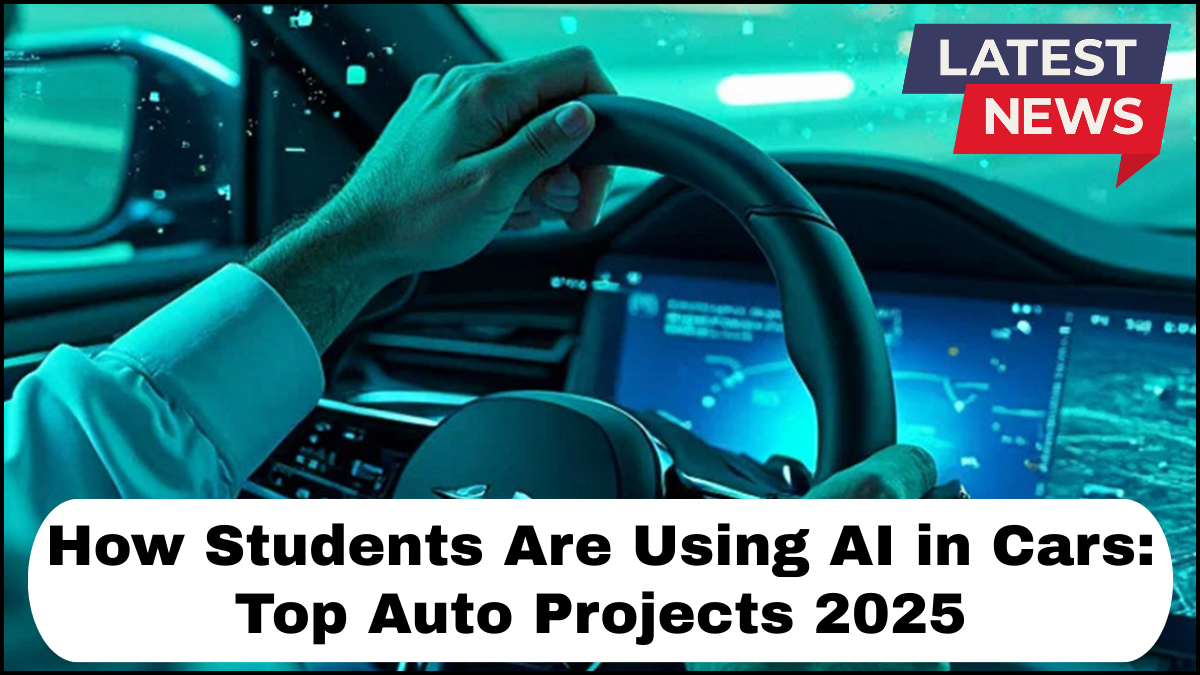Artificial intelligence (AI) has shifted from a buzzword to a core component of modern automotive technology. What’s more inspiring is how students—often at the undergraduate or postgraduate level—are not just studying AI in cars, but actively building the future of intelligent transportation. In 2025, student innovation in automobile projects is pushing boundaries, developing cutting-edge solutions with real-world impact. From smart driving assistants to autonomous racing prototypes, here’s a closer look at how students are shaping the next generation of mobility.

Smart Navigation Systems with Real-Time Adaptability
One of the most common applications of AI in cars is intelligent navigation. Students are creating navigation systems that go beyond static GPS. By integrating AI algorithms, these systems analyze real-time traffic data, weather conditions, and even driving habits to recommend the safest and fastest routes.
For instance, a group at the University of Waterloo recently developed an AI-based route planner that recalibrates based on predictive congestion modeling. Unlike traditional systems, it anticipates traffic jams and reroutes preemptively—improving both travel time and fuel efficiency.
Autonomous Driving Prototypes from the Ground Up
Autonomous vehicles remain the holy grail of AI in automotive engineering. Student teams across the globe are actively working on self-driving prototypes as part of major automobile projects. These aren’t just theoretical models—they’re functional vehicles with on-board sensors, LIDAR systems, and deep learning-based control algorithms.
Take the example of the MIT Driverless team. They’ve developed a Formula Student-style racing car capable of navigating complex tracks without any human input. Using convolutional neural networks and reinforcement learning, the vehicle can make high-speed decisions in real-time. It’s a clear demonstration of how student innovation is fast-tracking the practical use of AI in cars.
Predictive Maintenance Systems to Reduce Downtime
Students are also applying machine learning to solve a less glamorous but equally critical issue: vehicle maintenance. Predictive maintenance tools powered by AI can detect early signs of wear and tear, identify faulty components, and forecast potential breakdowns.
One standout example comes from the Indian Institute of Technology (IIT) Madras, where engineering students created a system that uses onboard diagnostics and AI to predict engine failures before they happen. The tool not only extends the vehicle’s lifespan but also lowers operating costs—a practical solution with commercial viability.
AI-Enhanced Driver Assistance and Safety
Driver assistance is another area where student-led automobile projects are gaining momentum. These systems aim to reduce human error and improve road safety through features like fatigue detection, blind-spot monitoring, and automatic braking.
A team at Stanford University has prototyped an AI-powered driving assistant that monitors facial expressions and eye movement to detect drowsiness. If a driver appears fatigued, the system triggers an alert or even shifts control to autonomous mode if needed. Projects like this illustrate the life-saving potential of AI in cars when combined with student-led creativity.
Eco-Driving Algorithms for Sustainable Transport
In 2025, sustainability is a major concern, and students are meeting the moment with AI-driven eco-driving solutions. These projects focus on reducing emissions and optimizing fuel consumption through intelligent throttle, brake, and gear control.
Students at the Technical University of Munich developed an AI model that adjusts driving behavior based on terrain, vehicle load, and driver profile. The result: up to 18% improvement in fuel efficiency during urban driving. As governments push for greener transport, these projects could offer scalable models for commercial fleets.
Human-Machine Interface (HMI) Innovations
AI doesn’t just control the vehicle—it also redefines how drivers interact with it. Many student automobile projects now focus on Human-Machine Interfaces (HMI), aiming for intuitive, voice-driven commands and gesture recognition systems.
For example, students at KAIST (Korea Advanced Institute of Science and Technology) have built an AI-based dashboard assistant that understands natural language and adapts to user preferences over time, controlling everything from entertainment to climate settings. It’s a fusion of AI with user-centric design, making cars feel more personal and intelligent.
Frequently Asked Questions (FAQ)
Q1: How are students accessing the technology to build AI in cars?
A: Most universities provide access to open-source AI libraries, simulation platforms, and sponsored hardware. Collaborations with automotive companies also offer students access to high-end tools.
Q2: What programming languages are commonly used in these automobile projects?
A: Python and C++ are the most popular due to their strong libraries for machine learning and embedded systems. ROS (Robot Operating System) is also commonly used in robotics-based vehicle projects.
Q3: Are student AI projects actually used in commercial vehicles?
A: While many are prototypes, some innovations have been licensed or adopted by startups and auto manufacturers. They often serve as proof-of-concept for scalable commercial applications.
Q4: What are the biggest challenges students face in AI car projects?
A: Hardware limitations, safety regulations, and the complexity of real-world data are major hurdles. However, many students use simulation tools to overcome physical constraints and refine their models.
click here to learn more